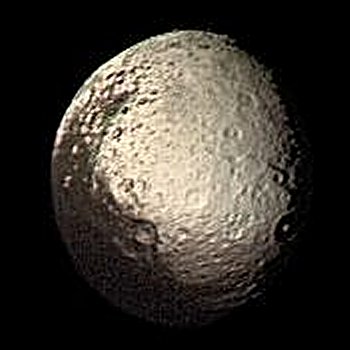 |
This is a file from the Wikimedia Commons. Information from its description page there is shown below.
Commons is a freely licensed media file repository. You can help.
|
- Iapetus by Voyager 2 spacecraft, August 22, 1981
- same as Iapetus_by_Voyager_2.jpg but focused on the moon and feature-enhanced.
- original image caption: Saturn's outermost large moon, Iapetus, has a bright, heavily cratered icy terrain and a dark terrain, as shown in this Voyager 2 image taken on August 22, 1981. Amazingly, the dark material covers precisely the side of Iapetus that leads in the direction of orbital motion around Saturn (except for the poles), whereas the bright material occurs on the trailing hemisphere and at the poles. The bright terrain is made of dirty ice, and the dark terrain is surfaced by carbonaceous molecules, according to measurements made with Earth-based telescopes. Iapetus' dark hemisphere has been likened to tar or asphalt and is so dark that no details within this terrain were visible to Voyager 2. The bright icy hemisphere, likened to dirty snow, shows many large impact craters. The closest approach by Voyager 2 to Iapetus was a relatively distant 600,000 miles, so that our best images, such as this, have a resolution of about 12 miles. The dark material is made of organic substances, probably including poisonous cyano compounds such as frozen hydrogen cyanide polymers. Though we know a little about the dark terrain's chemical nature, we do not understand its origin. Two theories have been developed, but neither is fully satisfactory--(1) the dark material may be organic dust knocked off the small neighboring satellite Phoebe and "painted" onto the leading side of Iapetus as the dust spirals toward Saturn and Iapetus hurtles through the tenuous dust cloud, or (2) the dark material may be made of icy-cold carbonaceous "cryovolcanic" lavas that were erupted from Iapetus' interior and then blackened by solar radiation, charged particles, and cosmic rays. A determination of the actual cause, as well as discovery of any other geologic features smaller than 12 miles across, awaits the Cassini Saturn orbiter to arrive in 2004
- image source: http://photojournal.jpl.nasa.gov/catalog/PIA00348
| Public domainPublic domainfalsefalse |
 |
This file is in the public domain because it was solely created by NASA. NASA copyright policy states that "NASA material is not protected by copyright unless noted". (See Template:PD-USGov, NASA copyright policy page or JPL Image Use Policy.) |
|
|
|
Warnings:
- Use of NASA logos, insignia and emblems are restricted per US law 14 CFR 1221.
- The NASA website hosts a large number of images from the Soviet/ Russian space agency, and other non-American space agencies. These are not necessarily in the public domain.
- Materials based on Hubble Space Telescope data may be copyrighted if they are not explicitly produced by the STScI. See also {{ PD-Hubble}} and {{ Cc-Hubble}}.
- The SOHO (ESA & NASA) joint project implies that all materials created by its probe are copyrighted and require permission for commercial non-educational use.
- Images featured on the Astronomy Picture of the Day (APOD) web site may be copyrighted.
|
File usage
The following pages on Schools Wikipedia link to this image (list may be incomplete):





